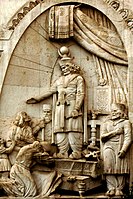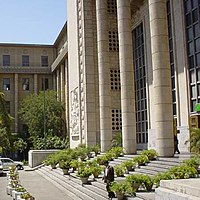Courthouse of Tehran
This article includes a improve this article by introducing more precise citations. (September 2020) ) |
| Courthouse of Tehran Kāx e Dādgostari ye Tehrān (Persian) | |
|---|---|
 Courthouse of Tehran in 1970s | |
 | |
| General information | |
| Architectural style | Neoclassical |
| Location | Tehran, Iran |
| Country | Iran |
| Coordinates | 35°40′54″N 51°25′08″E / 35.6816°N 51.4189°E |
| Completed | 1946 |
| Design and construction | |
| Architect(s) | Stanislav Suva |
Courthouse of Tehran (کاخِ دادگستریِ تهران – Kāx e Dādgostari ye Tehrān), also known as the Palace of Justice, is a historical courthouse in Tehran, Iran. The building was designed by Czechoslovak architect Stanislav Suva in the Neoclassical style to house 1,200 employees, serving as the Ministry of Justice, the law court, and the criminal and civil courts. Architecturally, the most important features of the building are the entrance hall, the main court hall, the offices and side rooms for the court, and the dining area and kitchen. Skoda began construction on the Palace of Justice between 1938 and 1946. Ing Arch Suva, a Czech architect who studied at the University of Architecture and Civil Engineering in Prague before being employed by "Société Iranienne Skoda", elaborated the sketch for the front face of the building in "European monumental conception".
It was necessary the architecture had a sense of permanence and a contemporaneous character in an Iranian style, which is intelligible to Iranian people but freed from excessive archaism. The designs for skirting parts had been elaborated by lead architect Suva and was entrusted to architect Tiyvoran. Architects Kopp and
During 1940 Suva was ordered to return to
Construction on the building was suspended during World War II during the reign of Reza Shah Pahlavi.
Today, the High Council of the Judiciary is based in this building.
Gallery
-
Justicebas relief author by Stanislav Suva; Sculptor Lajoš Biró
-
Statue ofAnushirawan the Justby Qolam Reza Rahimzade Arzhang
-
View from the side
-
View of the front part




